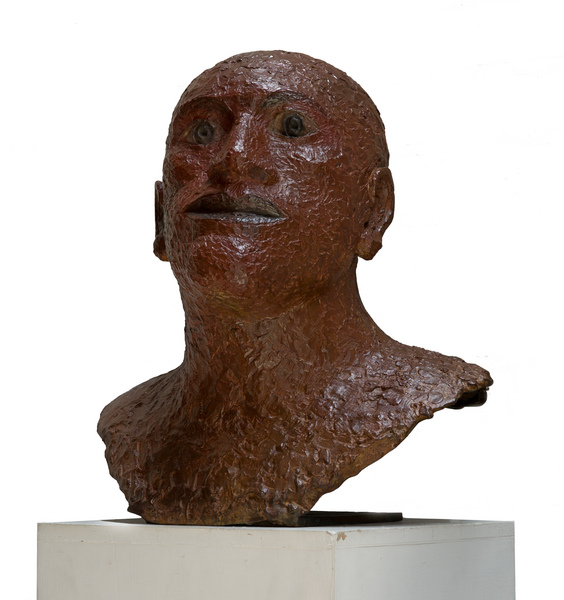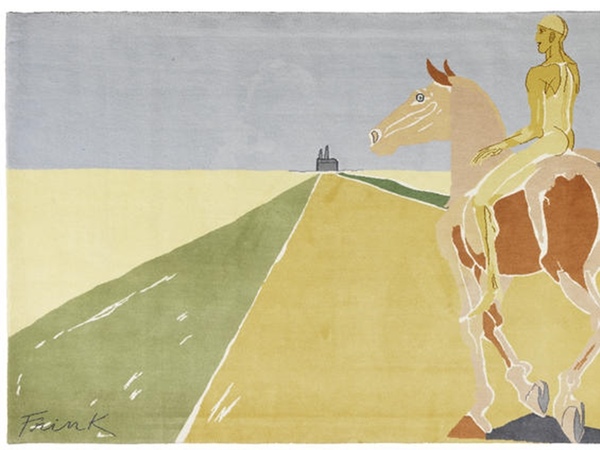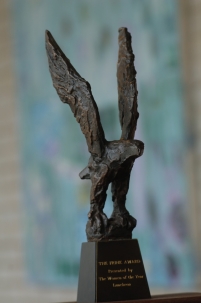Elisabeth Frink
Born 1930 Suffolk, England
Died 1993 Dorset, England
Biography
Elisabeth Frink was a sculptor best known for her depictions of the male form and animals, and in particular birds. Religious motifs and themes of masculine strength, struggle, and aggression feature prominently in her work. She studied at Guildford School of Art (1946–9) and Chelsea School of Art (1949–53). By the age of 22 she had sold her first artwork to the Tate. Apart from a brief affiliation with the avant-garde sculptural movement Geometry of Fear in the 1950s, Frink pursued an individual vision, producing more than 400 sculptures over the course of her career without even the help of an assistant. Light and content determine the texture of each work, with the sculptures themselves vessels to comprehend inner feeling and movement. Textures range from craggy, rough, and expressionist, to smoother and more self-contained, created through the application of wet plaster onto metal armature before casting. Advocate of en plein or outdoors sculpture, Frink completed several public commissions, including the Walking Madonna (1981) at Salisbury Cathedral and Risen Christ (1993) at Liverpool Cathedral. It was in the open air or beside great architecture that she believed sculpture to best communicate its meaning.
Artwork Information
Easter Head I (1989)
Easter Head I (1989) speaks to Elisabeth Frink’s wider artistic fascination with the male form, as seen in her series of male busts. Her interest in this subject began during World War Two. Living nearby to an airfield in Suffolk, she became aware of male bombers, and especially the captivating glamour of the uniforms and wider paraphernalia of war.
The outsized heads and torsos sculpted by Frink speak to an archetypal and impersonal grandeur. The bulkiness of Easter Head I – created by a shallow brow and thick lips – are in keeping with her many brutal male forms, speaking to a self-described preoccupation with ‘thuggishness’. Meanwhile, the fixed stare contributes to a stoic expression, with its associations of spirituality that can be interpreted in relation to the title and the wider significance of religion to the artist.
On the Road to Chartres (1983)
The wool tapestry On the Road to Chartres (1983) depicts man and horse en route to the town of Chartres in France, home to a magnificent Catholic cathedral. The title alludes to this location as a site of pilgrimage. Frink was a Christian who described herself as alienated from the Catholic faith in which she had been brought up. Nevertheless, she retained a strong Christian belief, completing several commissions for churches and cathedrals throughout her career.
By the mid-1960s, Frink had become obsessed with depicting the classical male nude, and in particular the relationship between man and horse. Together with dogs, Frink describes how horses have been the closest companions of man throughout history. Works such as On the Road to Chartres explore the supportive relationship between man and beast. In some works, the man is stronger, and in others the man relies on the horse. The dual anatomy of man and horse are explored through the refined simplicity of line and form.
Resting Horse (1981)
Resting Horse (1981) resonates with the wider body of works by Elisabeth Frink that depict horses lying down, inspired by the horse she bought for her son that used to lie down in the stable. Both Resting Horse and On the Road to Chartres have a sculptural quality despite their two-dimensional nature, created through the careful and refined composition of colour. The earthy brown tones of Resting Horse speak to a primitivism that appealed to the artist about horses, explored through her many depictions of the animal in sculptural, print, and textile forms.





